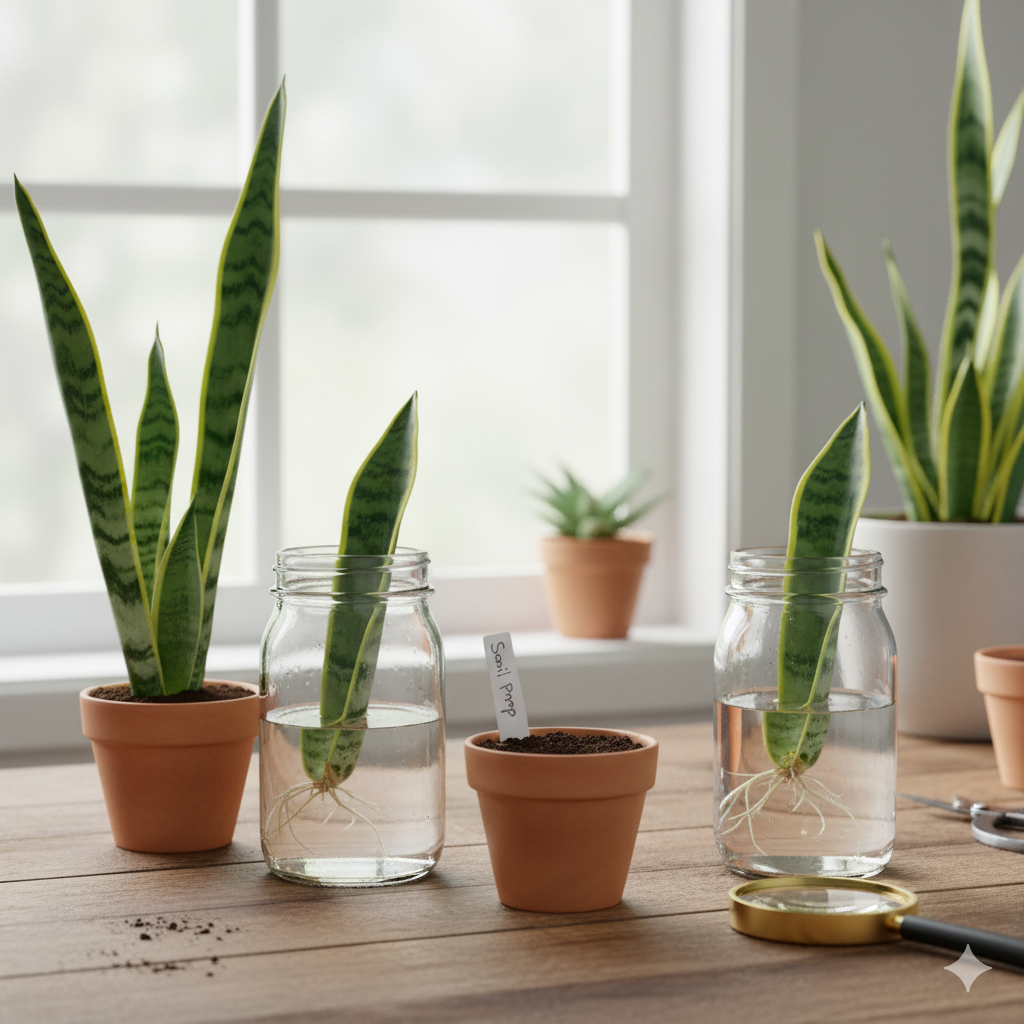Understanding Snake Plant Propagation
Propagation, in the context of plants, refers to the process of creating new plants from an existing specimen. This horticultural technique holds significant importance for enthusiasts seeking to expand their collection or share their plants with others. Snake plants, scientifically known as Sansevieria, stand out as remarkably suitable candidates for propagation due to their resilience and adaptability. These hardy plants are not only forgiving but also capable of thriving in a variety of conditions, which enhances their appeal to both novice and experienced gardeners.
There are several methods available for propagating snake plants, but the two most common techniques involve the use of water or soil. Each method presents unique advantages and caters to different preferences and circumstances. Propagating in water, for instance, allows for a visually engaging process where roots can be observed as they develop. Placing cuttings in a jar of water creates an unparalleled opportunity to observe the germination process, offering instant gratification for the gardener. In contrast, propagating in soil streamlines the growth directly in the medium where the plant will eventually thrive. This method can reduce the potential for transplant shock once the new plants mature.
The benefits of propagating snake plants extend beyond mere aesthetics. Cultivating more plants from the original can lead to substantial cost savings, as purchasing fully-grown plants can be financially burdensome. Additionally, the process of nurturing new growth fosters a sense of accomplishment and connection to the natural world. Whether for personal enjoyment or as a gift to others, propagating snake plants enriches the gardening experience, proving rewarding in many ways. By embracing propagation, one can cultivate a more diverse and flourishing collection of these beloved houseplants.
Propagating Snake Plants in Water
Propagating snake plants (Sansevieria) in water is an excellent method for new plant growth. To start, select healthy, mature leaves from an existing plant. Choose leaves that are at least 6 inches long and free of any blemishes or signs of disease. Using a clean, sharp knife or scissors, make a clean cut at the base of the leaf. It is advisable to cut the leaf into segments, about 2-3 inches in length, ensuring that the bottom of each segment is marked, as this will be where the roots will develop.
Once the cuttings are prepared, place them in a glass or jar filled with clean water, ensuring that the cut ends are submerged while the leaf tissue remains above the waterline. This promotes optimal conditions for rooting. To facilitate growth, position the jar in bright, indirect sunlight. Direct sunlight can cause the water to heat excessively and potentially damage the cuttings. Maintaining proper light conditions is crucial; too little light may delay root development, while too much can be detrimental.
Regularly changing the water is vital for ensuring the health of the cuttings. Aim to refresh the water every week to prevent stagnation and bacterial growth. Monitor the cuttings closely, as roots will begin to emerge from the cut ends after a few weeks. Root development typically takes two to six weeks, depending on the environmental conditions. Recognizing well-developed roots, usually around 2 inches long, indicates that it is time to transition the cuttings to soil.
Common mistakes during water propagation include using dirty containers or failing to change the water regularly, both of which can lead to rot. Another mistake is placing cuttings in direct sunlight, which can harm the young roots. By adhering to these guidelines, propagating snake plants in water can be a rewarding and efficient process, yielding new plants for your collection.
Propagating Snake Plants in Soil
Propagating snake plants in soil is a popular method for those who prefer to use potting soil for plant growth. To begin, gather the necessary materials, which include a high-quality potting soil, clean containers or pots with drainage holes, and healthy snake plant cuttings. Opt for a well-draining soil mix to promote root health and prevent rot, as snake plants are sensitive to overly moist environments.
Once you have your materials ready, it’s time to prepare the cuttings. Select healthy leaves from a mature snake plant, ensuring they are free from any diseases or pests. Cut the leaves into sections that are roughly four to six inches long, making sure to cut at a slight angle to facilitate moisture absorption. Allow the cuttings to rest for a day or two before planting, as this will enable the cut surfaces to callous over, reducing the risk of rot when placed in the soil.
Next, fill your containers with potting soil, making sure to leave enough space for the cuttings. Insert each cut end of the snake plant sections into the soil, ensuring that they are buried upright. Water the soil lightly, enough to moisten it without saturating. Place the containers in a warm, bright area with indirect sunlight, as direct sunlight may scorch the leaves. Maintaining consistent moisture in the soil is crucial; however, it is important to allow the top inch of soil to dry out between watering sessions.
As the new plants grow, monitor their progress closely. New growth can typically be recognized by the appearance of fresh leaves emerging from the soil. At this stage, you can adjust your care routine to include slightly more water and light exposure, ultimately fostering a strong environment for your snake plants to thrive. With careful attention and patience, propagating snake plants in soil can lead to a flourishing collection of these resilient plants.
Caring for Your Newly Propagated Snake Plants
After successfully propagating your snake plants, it is crucial to provide the appropriate care to ensure their continued growth and health. Whether your snake plants are in water or soil, understanding the specific needs of these resilient plants will optimize their development.
First and foremost, watering is a critical aspect of care for newly propagated snake plants. If your plants are situated in water, ensure that the water remains fresh and changes occur every two weeks to prevent root rot. For those planted in soil, allow the top inch to dry out before watering again, as snake plants are succulent and prefer a drier environment. Overwatering can lead to yellowing leaves and root issues, so it is essential to develop a consistent watering routine.
Light requirements also play a significant role in the health of your propagated snake plants. These plants thrive in indirect sunlight; however, they can tolerate low-light conditions. Therefore, place them in bright, indirect light environments for several hours daily. Conversely, extended exposure to harsh sunlight may scorch their leaves, so it’s vital to balance light exposure for optimal growth.
Fertilization is necessary for enhancing the growth of snake plants, particularly during their active growing season, which typically spans from spring to summer. Utilizing a balanced liquid fertilizer diluted to half strength every four to six weeks will boost their nutrient intake without overwhelming them. In fall and winter, reduce or halt fertilization as the plants enter dormancy.
Finally, monitor your plants for common issues such as yellowing leaves or stunted growth. Yellowing leaves may indicate overwatering, while slow growth could suggest insufficient light or nutrients. Addressing these issues promptly will help maintain the vibrant health of your snake plants.





